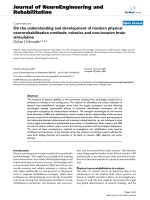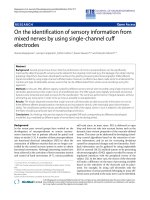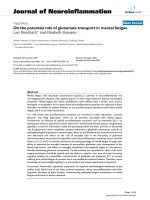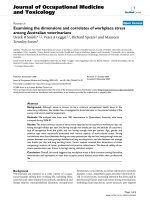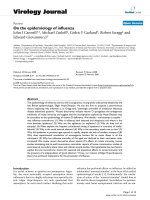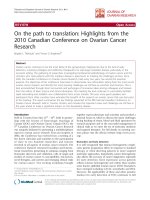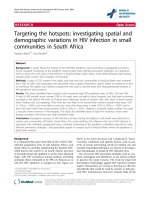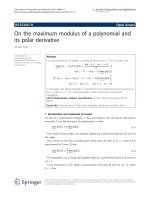báo cáo hóa học: " On the Lambert-W function for constrained resource allocation in cooperative networks" docx
Bạn đang xem bản rút gọn của tài liệu. Xem và tải ngay bản đầy đủ của tài liệu tại đây (354.62 KB, 13 trang )
RESEARCH Open Access
On the Lambert-W function for constrained
resource allocation in cooperative networks
Félix Brah
1*
, Abdellatif Zaidi
2
, Jérôme Louveaux
1
and Luc Vandendorpe
1
Abstract
In cooperative networks, a variety of resource allocation problems can be formulated as constrained optimization
with system-wide objective, e.g., maximizing the total system throughput, capacity or ergodic capacity, subject to
constraints from individual users, e.g., minimum data rate, transmit power limit, and from the system, e.g., power
budget, total number of subcarriers, availability of the channel state information (CSI). Most constrained resource
allocation schemes for cooperative networks require rigorous optimization processes using numerical methods
since closed-form solutions are rarely found. In this article, we show that the Lambert-W function can be efficiently
used to obtain closed-form solutions for some constrained resource allocation problems. Simulation results are
provided to compare the performance of the proposed schemes with other resource allocation schemes.
Keywords: Resource allocation, Lambert-W function, cooperative networks, QoS
1 Introduction
Cooperative transmissions have attracted much atten-
tion over the last few years. It has been demonstrated
that the benefi ts of multi-a ntenna transmission can be
achieved b y cooperative transmission without requiring
multiple antennas at individual nodes (for example see
[1-3]). Cooperation is particularly relevant when the size
of mobile devices limits the number of antennas that
can be deployed.
Wireless Mesh networks (WMN) and relay networks
are among the main networks that use cooperative com-
munication. The main distinguished characteristic of
mesh and relay networks is possibility of multi-hop
communication. In Mesh networks, traffic can be routed
through other mobile stations (MSs) and can also take
place through direct links. Nodes are composed of mesh
routers and mesh clients and thus routing process is
controlled not only by base station (BS) but also by
mobile station M S [4]. Eac h node can forward packets
on behalf of other nodes that may not be within direct
wireless transmission range of their destination. In case
of relay networks, the network infrastructure consists of
relay stations (RSs) that are mostly installed, owned, and
controlled by service provider. A RS is not connected
directly to wire infrastructure and has the minimum
functionality necessary to support m ulti-hop communi-
cation. The important aspect is that traffic always leads
from or to BS. The realization of the performance
improvement promised by cooperation in wireless mesh
and relay networks depends heavily on resource alloca-
tion (among other things).
Recently, resource allocation for OFDMA WMN with
perfect CSI has been an active research topic. In [5], a
fair subcarrier and power allocation scheme to maximize
the Nash bargaining fairness has been proposed. Instead
of solving a centralized global optimiza tion problem, the
authors proposed a distributed hierarchical approach
where the mesh router allocates groups of subcarriers to
the mesh clients, and each mesh client allocates trans-
mit power among its subcarrier s to each of its outgoing
links. In [6], an efficient intra-cluster packet-level
resource allocation approach taking into account power
allocation, subcarrier assignment, packet scheduling, and
QoS support has been studied. The authors employ the
utility maximization framework to find the joint power-
frequency-time resource allocation that maximizes the
sum rate of a WMN wh ile satisfying users minimum
rate requirements. The benefits of optimal resource allo-
cation in cooperative relay networks with perfect CSI
* Correspondence:
1
ICTEAM Institute, Université Catholique de Louvain, Place du Levant 2, 1348
Louvain-la-Neuve, Belgium
Full list of author information is available at the end of the article
Brah et al. EURASIP Journal on Wireless Communications and Networking 2011, 2011:19
/>© 2011 Brah et al; licensee Springer. This is an Open Access article distributed under the terms of the Creative Commons Attribution
License ( which permits unrestricted use, distribution, and reproduction in any medium,
provided the original work is properly cited.
has also been investigated by several a uthors (see, e.g.,
[7,8], and references therein).
However, when the channel variations are fast, the
transmitter may not be able to adapt to the instanta-
neous channel realization. Hence, CSI-aware resource
allocation is not suitable for environments with high
mobility. When the channel state can be accurately
tracked at the receiver side, the statistical channel model
at the transmitter can be based on channel distribution
information feedback from the receiver. We refer to
knowle dge of the channel distribution at the transmitter
as CDIT. I n [9], CDIT-based constrained resource allo-
cation problem for non-cooperative OFDMA-based net-
works is studied. The authors derive an optimal power
allocation algorithm in closed-form. In [10], a dynamic
resource allocation algorithm aiming to maximize the
delay-limited capacity of a cooperative communication
with statistical channel information is developed. In
[11], a power a llocation problem for ergodic capacity
maxi miza tion in relay networks under high SNR regime
is solved using numerical methods.
In this article, we present a new r esult on how the
Lambert-W function can be used to efficiently find
closed-form solution of constrained resource allocation
problems for cooperative networks.
There are two significant benefits from using the Lam-
bert-W function in the context of resource allocation for
cooperative networks. Most resource allocation schemes
for cooperative networks require rigorous optimization
processes using numerical methods since closed-form
solutions are rarely found. Using the Lambert-W func-
tion, resource allocations can not only be expressed in
closed-form but they can also quickly be determined
without resorting to complex algorithms since a number
of popular mathematical softwares, including Maple and
Matlab, contain the Lambert-W function as an optimi-
zation component.
The Lambert-W function has several uses in physical
and engineering applications [12-15]. In [14], the Lam-
bert-W function is used for the purpose of d iode para-
meters determination in diode I-U curve fitting. Recent
work in [15] shows that the Lambert-W function also
finds utilization in Astronomy to calculate the position
of an orbiting body in a central gravity field.
The remainder of this article is organized as follows.
In Sect. 2, we provide a concise introduction to the
Lambert-W function. In Sect. 3, we show how the Lam-
bert-W function is applied to a subcarrier allocation
problem in WMNs. The use of the Lambert-W function
to a power allocation problem in relay networks with
statistical channel information is discussed in Sect. 4. In
Sect.5,weshowtheperformanceoftheproposed
reso urce allocation methods by simulation. Finally, con-
clusions are drawn in Sect. 6.
2 The Lambert-W Function
The Lambert function W(x) is defined to be the multi-
valued inverse of the function f(x)=xe
x
[12]. That is,
Lambert W(x) can be any function solution of the trans-
cendental equation
W
(
x
)
e
W(x)
= x
.
(1)
Actually, for some values of x,Equation1hasmore
than one root, in which case the different solutions are
called branche s of W. Since the values of interest in our
work are real, we will concentrate on real-value
branches of W .Ifx is real, then for -1/e ≤ x <0,there
are two possible real values of W(x)(seeFigure1).The
branch satisfying W(x) ≤ -1 is denoted by W
0
( x). The
branch satisfying W(x) ≤ -1 is denoted by W(x) and it is
referred to as the principal branch of the Lambert-W
function.
The nth derivative of the Lambert-W function is given
by [12].
d
n
W(e
x
)
dx
n
=
q
n
(W(e
x
))
(
1+W
(
e
x
))
2n−1
for n ≥ 1
,
(2)
in which the polynomials q
n
, given by
q
n
(w)=
n−1
i
=
0
n − 1
i
(−1)
i
w
i+1
,
(3)
contain coefficients expresse d in terms of second-
order Eulerian numbers and q
1
(w)=w.
In (3), the second-order Eulerian number
n
m
cor-
responds to the number of permutations of the multiset
{1,1,2,2, ,n, n}withm ascents which have the prop-
erty that for each i, all the numbers appearing between
the two occurrences of i in the permutation are greater
than i [16].
The application of the L ambert-W function to obtain
a c losed-form solution for resource allocation problems
in wireless mesh and relay networks constitutes the
principal contribution of this article.
3 The Lambert-W function for subca rrier
allocation in wireless mesh network
3.1 Problem formulation
We consider a single cluster OFDMA WMN that consists
of one mesh router (MR) and K mesh clients (MC) as illu-
strated in Figure 2. The MR serves as a gateway for the
MCs to the external network (e.g., Internet). The MCs can
communicate with the MR and with each other through
multi-hop routes via other MCs. We label the MR as node
0 and the MC nodes as k = 1, , K. A link ( k , j)exists
between node k and node j when they are within transmis-
sion range of each other, i.e., they are neighboring nodes.
Brah et al. EURASIP Journal on Wireless Communications and Networking 2011, 2011:19
/>Page 2 of 13
Figure 1 The two real branches of the Lambert-W function.
Figure 2 Illustration of a wireless mesh network.
Brah et al. EURASIP Journal on Wireless Communications and Networking 2011, 2011:19
/>Page 3 of 13
ThereareatotalofN subcarriers in the system. Each
subcarrier has a bandwidth B. The channel gain of sub-
carrier n on link (k, j), which connects MC k to MC j,is
denoted by
G
n
k
j
and the transmit power of MC k on sub-
carrier n is denoted by
p
n
k
.MCk has a transmit power
limit of
¯
p
k
and a minimal rate requirement of R
k
.Letn
k
be the number of subcarriers to allocate to MC k,using
only information available at the MR, i.e., the average
channel gain of all outgoing links at MC k,
¯
G
k
. Based on
¯
G
k
and uniform power allocation assumption over all
the n
k
subcarriers
(p
n
k
=
¯
p
k
n
k
, ∀k
)
,theMRdetermines
an approximated rate for MC k as
r
k
(n
k
)=n
k
B log
2
1+
¯
G
k
σ
2
n
¯
p
k
n
k
,
(4)
where
σ
2
n
isthethermalnoisepower,andΓ is the
SNR gap related to the required bit-error-rate (BER).
The main reason that t he MR determines an approxi-
mated rate instead of the exact rate is that the MR
knows only the average channel gain
¯
G
k
, but not the
complete channel gain
G
n
k
j
. In general, exact and com-
plete information needed to determine the exact rate is
rarely available at the MR. For practical SNR values
(SNR > 5 dB), the gap between the exact rate and its
approximate (4) is very small and (4) can be viewed as
the rate realized at MC k.
There are various constraints associated with
resource allocation in OFDMA-based WMNs. At each
node k, the sum of the transmit power on the allocated
subcarriers is bounded by a maximum power level
¯
p
k
.
We assume that each subcarrier can only be allocated
to one transmission link in a cluster. Different traffic
types require different packet transmission rates. For
example, voice packets require a constant rate; video
traffic has minimum, mean, and maximum rate
requirements; while data traffic is u sually treated as
background traffic whose source rate is dynamic. In
our problem formulation, we only take the minimum
rate requirement of these three traffic types, if any,
into account.
The resources to allocated are defined as a set of
subcarriers, and the total transmit power available at
each node. We consider a distributed hierarchical
resource allocation, where the MR only performs a
rough resource allocation with limited information
(the average channel gain of all outgoing links at MC
or the statistical channel information) and the MCs
perform more refined resource allocation with full
information that is available locally. In this section, we
focus on subcarrier allocation at MR and we assume
that each MC k distributes its transmit power limit
¯
p
k
equally over all its allocated subcarriers. After
subcarrier allocation, the optimal power allocation is
performedateachMCk. The optimal power alloca-
tion is not developed in this article. Mathematicall y,
the subcarrie r allocation problem at MR can be formu-
lated as
max
n
k
K
k=1
n
k
B log
2
1+
α
k
n
k
subject to:
n
k
B log
2
1+
α
k
n
k
≥ R
k
K
k
=1
n
k
≤ N
(5)
where
α
k
=
¯
G
k
¯
p
k
σ
2
n
.
3.2 Solution method
We propose a solution method based on the Lagrange
dual approach and the Lambert-W function. First, we
express the Lagrangian of the primal problem (5) as
L(n
k
, λ
k
, μ)=
K
k=1
n
k
B log
2
1+
α
k
n
k
+
K
k
=1
λ
k
n
k
B log
2
1+
α
k
n
k
− R
k
− μ
K
k
=1
n
k
− N
(6)
where l
k
and μ are the La grangian multipliers asso-
ciated with the minimum rate constraint of MC k and
the total subcarrier constraint.
By KKT first optimality condition [17], we take the
derivative of (6) with respect to n
k
for fixed (l
k
, μ)and
set the derivative to zero to obtain
ln
1+
α
k
n
k
−
α
k
n
k
1+
α
k
n
k
−
μ
B
ln 2
(1 + λ
k
)
=0
.
(7)
By solving Equation 7 for n
k
,forgiven(l
k
, μ), the
optimal value of subcarriers to be allocated to MC k is
given by (see Appendix A)
n
∗
k
=
−α
k
W
−exp
−1 −
μ
B
ln2
(1 + λ
k
)
1+W
−exp
−1 −
μ
B
ln2
(1 + λ
k
)
.
(8)
The optimal values of μ and l
k
still need to be found.
They correspond to the ones that s atisfy the t otal sub-
carrier constraint with equality and the individual rate
constraints. We substitute n
k
in Equation 6 by
n
∗
k
to
form the dual problem
Brah et al. EURASIP Journal on Wireless Communications and Networking 2011, 2011:19
/>Page 4 of 13
min
λ
k
,
μ
L(n
∗
k
, λ
k
, μ)
.
(9)
The optimal
λ
∗
k
, fo r fixed μ, are found using KKT con-
ditions. To derive
L(n
∗
k
, λ
k
, μ
)
over l
k
,wemakeuseof
the formula of the nth derivative of the Lambert-W
function gi ven by (2). Applying (2) for n = 1, we obtain
that the optimal
λ
∗
k
has to satisfy (see Appendix B)
f
m
(λ
∗
k
) −
R
k
α
k
=0
,
(10)
where
f
m
(λ
∗
k
)=
w
∗
k
1+w
∗
k
·
B
ln 2
+
μ
(1 + λ
∗
k
)(1 + w
∗
k
)
2
ln (−w
∗
k
)
+
μ
(1 + λ
∗
k
)(1+w
∗
k
)
+
μ
2
(1 + λ
∗
k
)
2
(1 + w
∗
k
)
2
with
w
∗
k
= W
⎛
⎜
⎝
−exp
⎛
⎜
⎝
−1 −
μ
B
ln 2
(1+λ
∗
k
)
⎞
⎟
⎠
⎞
⎟
⎠
.
It can be shown that f
m
is a strictly increasing function
of
λ
∗
k
and
f
m
(λ
∗
k
) >
0
for all
λ
∗
k
≥
0
. Thus, the inverse
function,
f
−
1
m
,of f
m
,exists.Theoptimal
λ
∗
k
canthenbe
deduced as
λ
∗
k
= f
−1
m
R
k
α
k
.
(11)
Now we turn to find the optimal μ*. Substituting l
k
in
(8) by the optimal value obtained in (11) and using the
constraint
K
k
=1
n
k
=
N
, we obtain
K
k=1
−α
k
W
−exp
−1 −
μ
B
ln 2
(1 + λ
∗
k
)
1+W
−exp
−1 −
μ
B
ln 2
(1 + λ
∗
k
)
= N
.
(12)
Let
g
m
(μ)=
K
k=1
−α
k
W
−exp
−1 −
μ
B
ln 2
(1 + λ
∗
k
)
1+W
−exp
−1 −
μ
B
ln 2
(1 + λ
∗
k
)
.
(13)
Proposition 1 An inverse function for g
m
,
g
−
1
m
, exists
(see Appendix C. for proof).
Thus
μ
∗
= g
−1
m
(N )
.
(14)
3.3 Extension to Mesh router with statistical channel
information
In some fading environments, there may not be a feed-
back link sufficiently fast to convey the full CSI to the
MR. The MR may know only the channel distribu tion
information (CDI) and may use the CDI to allocate
resource. Following the approach in [9], we can formu-
late an ergodic rate maximization problem at the mesh
router with only CDI as
max
n
k
E
α
K
k=1
n
k
B log
2
1+
α
k
n
k
subject to:
E
α
k
n
k
B log
2
1+
α
k
n
k
≥ R
k
K
k
=1
n
k
≤ N
(15)
where a =[a
1
, a
2
, , a
k
, , a
K
], and E
a
{.} represents
the statistical expectation with respect to a.
Using the solution method proposed in 3.2, the o pti-
mal subcarrier allocation solution of (15) can be
obtained by solving the following equation for
˜
n
k
E
α
k
ln
1+
α
k
˜
n
k
−
α
k
˜
n
k
1+
α
k
˜
n
k
−
μ
B
ln 2
(1 + λ
k
)
=0
.
(16)
To express the left hand side of (16), we need to find
the probability density function (pdf) of the random
variable
˜
f
m
(
α
k
)
=ln
1+
α
k
˜
n
k
−
α
k
˜
n
k
1+
α
k
˜
n
k
−
μ
B
ln 2
(1 + λ
k
)
.
(17)
It can be observed that
˜
f
m
is monotonically nonde-
creasing and non-nega tive with respect to a
k
.Thus,
there exists a unique inverse function,
˜
f
−
1
m
,of
˜
f
m
.
Let
˜
F
α
k
(α
k
)
and
˜
T
α
k
(α
k
)
denote the cumulative distri-
bution function (cdf) and the pdf of a
k
. We assume that
˜
F
α
k
(α
k
)
and
˜
T
α
k
(α
k
)
are known at the MR.
First, using the same derivation as in Appendix A
where the right hand side of equ ation (A.1) is
˜
f
m
instead
of 0, we can express the inverse function of
˜
f
m
as
˜α
k
˜
f
m
=
−
˜
n
∗
k
1+W
−exp
−1 −
μ +
˜
f
m
B
ln 2
(1 + λ
k
)
W
−exp
−1 −
μ +
˜
f
m
B
ln 2
(1 + λ
k
)
.
(18)
Brah et al. EURASIP Journal on Wireless Communications and Networking 2011, 2011:19
/>Page 5 of 13
Using expression (18) for the root, we derive the cdf
of
˜
f
m
as
˜
F
˜
f
m
˜
f
m
= F
α
k
˜α
k
˜
f
m
.
(19)
The pdf of
˜
f
m
is then given as the derivative of (19)
with respect to
˜
f
m
as
˜
T
˜
f
m
˜
f
m
=
˜
T
α
k
˜α
k
˜
f
m
1+ ˜α
k
˜
f
m
2
B
ln 2
(1 + λ
k
)
˜
n
∗2
k
.
(20)
Finally, using (20), the optimal subcarrier assignment
˜
n
∗
k
is obtained by solving the following equation for
˜
n
∗
k
∞
0
˜
f
m
˜
T
˜
f
m
˜
f
m
d
˜
f
m
=0
.
(21)
For given multipliers l
k
and μ, Equation 21 can be
solved numerically.
The optimal values of l
k
,(k Î [1, K]) and μ still need
to be found. They correspond to the ones that satisfy
the individual rate constraints and the total subcarriers
constraint ( with equality). If some of the individual rate
constraints are exceed ed, the corresponding l
k
is equal
to zero. Unlike in the instantaneous allocation where
we have derive closed forms for l
k
and μ,hereitisnot
easy to obtain a close form. We use an iterative search
algorithm to find the optimal set of l
k
and μ.
4 The Lambert-W function for CDIT-based power
allocation in relay networks
In this section, we show how the Lambert-W Function
can be used for constrained resource allocation in relay
networks.
4.1 Problem formulation
Consider the relay network operating in receiver coop-
eration mode as illustrated in Figure 3. The transmitter
at the source node sends a signal x. Let x
1
and y
1
denote
the transmitted and received signals at the relay node,
respectively. We assume that the relay node operates in
the full duplex mode, i.e., the relay can receive and
transmit simultaneously on the same frequency channel
[7]. Thus, the recei ved signals at the relay node and the
destination node are given by
y
1
= h
2
x + z
1
y = h
1
x +
√
gh
3
x
1
+ z
,
(22)
where z
1
and z are independent identically distributed
(i.i.d) zero mean ci rcularly symmetric complex Gaussian
(ZMCSCG) additive noise with unit variance.
Thecapacitycutsetboundoftherelaynetworkof
Figure 3 operating in a full duplex mode with perfect
CSI can be expressed as [11]
C
inst
=max
0≤ρ,β ≤1
min
log
2
(1 + βP(1 −ρ
2
)(γ
1
+ γ
2
)),
log
2
1+βPγ
1
+
(1 −β)g +2ρ
β(1 − β)g
Pγ
3
,
(23)
where r represents the correlation between the trans-
mit signals of the transmitter and the relay, and g
i
=|h
i
|
2
.
We assume Rayleigh fading where each channel gain
h
i
, i =1,2,3,isi.i.d.andnormalizedtohaveunitvar-
iance; hence, the corresponding channel power gain is i.
i.d. exponential with unit mean. The average channel
power gain between the rela y and the receiver is g.We
assume that g characterizes only path-loss attenuation,
hence g =1/d
a
,whered is the distance between the
relaynodeandthereceivernodeanda is the path-loss
power attenuation exponent. As in receiver cooperation
mode the relay is assumed to be close to the receiver,
the scenario of interest is when d is small.
Figure 3 Illustration of a relay network operating in receiver cooperation mode.
Brah et al. EURASIP Journal on Wireless Communications and Networking 2011, 2011:19
/>Page 6 of 13
We consider a fast fading environment, where the recei-
ver has CSI to perform coherent detection, but there is no
fast feedback link to convey the CSI to the transmitter.
Hence, the transmitter only has CDI, but no knowledge of
the instantaneous channel realizations. Ergodic capacity is
used to characterize the transmission rate of the channel.
We assume the channel has unit bandwidth. We
further assume an average network power constraint on
the system:
E
|
x
|
2
+
|
x
1
|
2
≤ P
,
(24)
where the expectation is taken over repeated channel
uses.
The network power constraint model is applicable
when the node configuration in the network is not fixed
[11]. Note that, when the node configuration is fixed,
the individual power constraint model reflects the prac-
tical scenarios more than the network model. However,
the power allocation problem is, in general, more tract-
able under network power constraint.
The total power P is optimally allocated between the
transmitter and the relay, i.e.,
E
|
x
|
2
≤ βP, E
|
x
1
|
2
≤ (1 −β)P
,
(25)
where b Î [0,1] is parameter to be optimized based on
CDI and node geometry g.
It has been shown in [7] that the capacity upper
bound in the asynchronous channel model, i.e., the
channel model where the nodes do not have complete
CSI, can be found by setting the correlation r to zero.
Since the CDI channel model falls into this case, the
ergodic capacity upper bound can be found by taking
the expectation of (23) over the channel distribution
and setting r = 0. Making use of the high SNR (P ≫ 1)
approximation log(1 + xP) ≈ log(xP ), the ergodic capa-
city upper bound is then given by
C
erg
=max
0≤β≤1
min
E[log
2
(βP(γ
1
+ γ
2
))],
E[log
2
(βPγ
1
+(1− β)Pg γ
3
)]
.
(26)
The problem is to find the optimal power allocation, i.
e., the optimal value of b, that gives the capac ity upper
bound C
erg
(b) of (26). Mathematically the power alloca-
tion problem can be formulated as
max
0
≤β≤1
min
E[log
2
(βP(γ
1
+ γ
2
))],
E[log
2
(βPγ
1
+(1− β)Pgγ
3
)]
.
(27)
Problem (27) has been addressed in [11] and a numer-
ical solution has been proposed, but no closed-form
expression has been provided. This contrasts with what
will be done here.
4.2 Solution method
To find the optimal power allocation in closed-form, we
propose an approach that uses the Lambert-W function.
First, we need to evaluate the expected value of the
capacity expression over the channel fading distribution.
For this end, we make use of the following formula for i.i.
d. exponential random variables X
1
, X
2
with unit mean:
E[log(a
1
X
1
+ a
2
X
2
)]
=
⎧
⎨
⎩
a
1
loga
1
− a
2
loga
2
a
1
− a
2
− log e
γ
if a
1
= a
2
log a
1
+loge
1−γ
if a
1
= a
2
,
(28)
where a
1
and a
2
are positive scalar constants and g is
Euler’s constant.
Applying formula (28), the first term and the second
term inside the min{.} in e xpression (26) are given,
respectively, by
E [log
2
(βP(γ
1
+ γ
2
))] = log
2
P +log
2
β +log
2
e
1−γ
,
(29)
and
E[log
2
(βPγ
1
+(1−β )Pgγ
3
)] =log
2
P
+
g(1 − β)log
2
g(1 − β)
− βlog
2
β
g
(
1 − β
)
− β
− log
2
e
γ
.
(30)
Expression (29) is an increasing function of b.Itis
easy to show that expression (30) is a decreasing func-
tion of b (for g of interest, i.e., g > 1). Thus the optimal
value b* solution of the maximization problem (27) can
be found by equating expressions (29) and (30) as
log
2
P +log
2
β
∗
+log
2
e
1−γ
=log
2
P
+
g (1 − β
∗
)log
2
(g (1 − β
∗
)) − β
∗
log
2
β
∗
g
(
1 − β
∗
)
− β
∗
− log
2
e
γ
.
(31)
Equation 31 is equivalent to
ln (β
∗
)+1=
g(1 −β
∗
)ln(g(1 −β
∗
)) − β
∗
ln (β
∗
)
g
(
1 − β
∗
)
− β
∗
,
(32)
where ln(x) is the natural logarithm of x.
After some algebraic manipulations (32) can be rewrit-
ten equivalently as
−β
∗
g (
1 − β
∗
)
exp
−β
∗
g
(
1 − β
∗
)
= −
1
e
.
(33)
It can be recognized that Equation 33 is in the form of
a transcendental Equation 1. Thus we have
W
−
1
e
=
−β
∗
g
(
1 − β
∗
)
.
(34)
The optimal value b* is deduced from (34) as
β
∗
=
K
g
K
g
+1
,
(35)
Brah et al. EURASIP Journal on Wireless Communications and Networking 2011, 2011:19
/>Page 7 of 13
where
K = −W
−
1
e
=
1
.
It is interesting is to observe that the optimal power
allocation is obtained in cl osed-form and depends only
on g, i.e., on the distance d between the relay node and
the destination node and the path-loss power attenua-
tion exponent a.
4.3 Comparison with CSIT-based power allocation
In order to assess the relevance of the CDIT-based
approach, it has to be compared to the a llocation
scheme based on perfect CSIT. Perfect CSIT is unrealis-
tic, but for the purpose of comparison, let us assume
perfect CSIT. Then the power allocation can be formu-
lated to maximize the instantaneous capacity instead of
the ergodic capacity. Mathematically, the CSIT-based
power allocation can be formulated as
max
0
≤ρ,β≤1
min
1
2
log
2
(1 + βP(1 − ρ
2
)(γ
1
+ γ
2
)),
1
2
log
2
1+βPγ
1
+
(1 − β) g +2ρ
β (1 − β)g
Pγ
3
.
(36)
The optimal v alues of r and b solution of (36) have
been found in [11] as
ρ
∗
=
1
g
2
+2g +2
,
(37)
β
∗
=
g
2
+2g +2
g
2
+3
g
+2
.
(38)
The instantaneous capacity upper boun d for high SNR
regime is deduced as
C
inst
=log
2
2
g +1
g +2
P
.
(39)
Both CDIT-based and CSIT-based optimal power allo-
cation expressions (35) and (38) are in closed-form and
very fast to compute. Thus, the complexity is almost the
same. The main difference between the two allocation
schemes is the amount of feedback required to perfo rm
power allocation. Recall that, for the CSIT-based
scheme, the allocation is performed after each symbol
period. Let N
s
be the number o f symbol periods after
which the CDIT-based resource allocation is performed.
Then a rough estimation tells us that the feedback
needed to perform CDIT-based power allocation is
reduced by
1
N
s
compared to the perfect CSIT scheme.
5 Simulation results
In order to assess the performance o f the proposed
resource allocation methods, we conduct simulations
and compare the simulation results with other baseline
schemes.
5.1 Simulation results for wireless mesh networks
We consider a clust er with four wireless nodes with the
scheduling tree topology shown in Figure 4 and 4a total
number of subcarriers N =128overa1-MHzband.
The relative effective SNR difference between MC 1 (the
closest MC to the MR) and MC 2, 3, and 4 are 3, 6, and
10 dB, respectively. The minimum rate requirements are
chosen to be the same for all MCs, the maximal power
at each MC k is
¯
p
k
=50mW
, the th ermal noise power
is
σ
2
n
=10
−11
W
.
We assume a Rayleigh fading. Thus, for the CDI-based
allocation, the a
k
follow a c
2
distribution with 2L
k
degree of freedom, where L
k
is the number of outgoing
links at MC k. For MC with a single outgoing link, a
k
is
reduced to an exponential distribution.
We name the proposed scheme with optimal alloca-
tion at MR and MCs as full optimal resource allocation
(FORA). For comparison, we also implement the follow-
ing resource allocation schemes:
1. MR-based optimal resource allocation (MORA)
where the MR performs the proposed optimal
subcarrier assignment, but each MC performs
uniform power allocation among its outgoing
links.
2. Full uniform resource allocation (FURA) where
each MC is assigned the same number of subcarriers
and transmit power at each MC is uniformly distrib-
uted over the assigned subcarrie rs and the active
links.
We evaluate system performance in terms of sum rate,
and satisfaction of minimum rate requirements.
In Figure 5, the performance of the proposed FORA
is compared to that of the optimal resource allocation
at MR under uniform power allocation at MCs
(MORA) and the FURA. The result shows that the
proposed optimal reso urce allocation brings significant
gain over uniform resource allocation, especially for
low SNRs.
Figure 6 shows the user’s rate for different allocation
schemes when the users minimum data rate demands
are constrained to R
k
= 1 Mbps for all MCs. We
observe that under optimal allocation, the need of all
users in terms of data rate is satisfied. This is not t he
case under uniform allocation. With uniform alloca-
tion, there is an over-allocation for closer MCs to the
MR (MCs 1 and 2) while the rate demand of farer
users with bad channel conditions (MCs 3 and 4) are
not satisfied.
Brah et al. EURASIP Journal on Wireless Communications and Networking 2011, 2011:19
/>Page 8 of 13
0 5 10 15 20 25 30
1
1.5
2
2.5
3
3.5
4
4.5
5
5.5
mean SNR (dB)
maximized sum rate (Mbps)
FORA
MORA
FURA
Figure 4 Network topology used in the simulations.
1 2 3 4
0
0.5
1
1.5
MC node ID (k)
rate per MC (Mbps)
min. rate req. (R
k
)
FORA
MORA
FURA
Figure 5 Maximized sum rate versus mean SNR for various resource allocation schemes.
Brah et al. EURASIP Journal on Wireless Communications and Networking 2011, 2011:19
/>Page 9 of 13
5.2 Simulation results for relay networks
In all the simulations, we assume a path-loss power
attenuation exponent of 2, and hence g =1/d
2
. The dis-
tance d between the relay node and the receiver node
varies from 0.1 to 1.
In Figure 7, the ergodic capacity achieved using the
proposed power allocation scheme is compared to the
one obtained with uniform power allocation (b =0.5,
∀d Î [0.1, 1]). We consider system average network
power constraints of P =10andP = 100. It can be
observed that the achieved capacity using the proposed
optimal power allocation metho d outperforms the capa-
city obtained with uniform allocation.
Figure 8 illustrates the achieved capacity using the
proposed CDIT-bas ed optimal power allocation (35)
in comparison with the capacity of the CSIT-based
optimal power allocation (38). The CSIT-based capa-
city is averaged over the same number of c hannel rea-
lizations N
s
over which the distribution is taken to
evaluate the ergodic capacity. The result shows that
the gap between the average capacity and the ergodic
capacity is small. Thus, even with CDIT only, optimal
power allocation improves performance of relay
networks.
The trade-off between reduced feedback and perfor-
mance degradation of the proposed CDIT-based optimal
power allocation in comparison with the perfect CSIT-
based optimal power allocation is shown in Figure 9.
We observe that adapting the transmis sion strategy to
the short-term channel statistics, increases the perfor-
mance but also increases the amount of feedback. How-
ever, if the transmission is adapted to the long-term
channel statistics, the amount of feedback decreases sig-
nificantly but with a penalty on the performance. For a
CDIT-based allocation with a distribution taken over 16
Figure 6 Per mesh client rate for R
k
= 1 Mbps.
0.1 0.2 0.3 0.4 0.5 0.6 0.7 0.8 0.9 1
2.5
3
3.5
4
4.5
5
5.5
6
6.5
7
7.5
Distance d
Capacity (bps)
optimal PA, P=100
uniform PA, P=100
optimal PA, P=10
uniform PA, P=10
Figure 7 Maximized capacity versus distance d for CDIT-based optimal power allocation and uniform power allocation.
Brah et al. EURASIP Journal on Wireless Communications and Networking 2011, 2011:19
/>Page 10 of 13
symbol periods, the amount of feedback is reduced by
93.75%, while the performance degradation in terms of
capacity is less than 12%.
6 Conclusion
We have addressed constrained resource allocation pro-
blems for wireless mesh and relay networks. For mesh
networks, we have formula ted a dist ributed subcarrier
allocation problem to maximize the sum rate while
satisfying minimum rate demand. For relay networks,
we have formulated power allocation problem to maxi-
mize the ergodic capacity under total power constraint.
Both cases of perfect and statistical channel knowledge
at the transmitter have been considered. We have
shown ho w the Lambert-W function can be use to effi-
ciently find the optimal resource allocation in closed-
form. Using the Lambert-W function, resource alloca-
tion can quickly be determined since a number of popu-
lar mat hematical softwares, including Maple and
Matlab, contain the Lambert-W function as an optimi-
zation component. The Lambert-W function can be
combined with the Lagrange dual approach to solve
variety of wired and wireless resource allocation
problems without resor ting to complex numerical
algorithms.
Appendix
Appendix A: Derivation of (8)
Equation 7 can be rewritten as
ln
n
k
n
k
+ α
k
−
n
k
n
k
+ α
k
+1+
μ
B
ln 2
(1 + λ
k
)
=0
.
(A:1)
Equation A.1 can be rewritten equivalently as
−
n
k
n
k
+ α
k
e
−
n
k
n
k
+α
k
= −exp
−1 −
μ
B
ln 2
(1 + λ
k
)
(A:2)
Expression (A.2) is in the form of the Lambert-W
function W(x), which is the solution to W(x)e
W(x)
= x.
Thus, from (A.2) we can deduce that
W
−exp
−1 −
μ
B
ln 2
(1 + λ
k
)
= −
n
k
n
k
+ α
k
(A:3)
which when then solved for n
k
gives (8).
0.1 0.2 0.3 0.4 0.5 0.6 0.7 0.8 0.9 1
2.8
3
3.2
3.4
3.6
3.8
4
4.2
4.4
Distance d
Capacity (bps)
CSIT−based optimal PA
CDIT−based optimal PA
Figure 8 Maximized capacity versus distance d for CDIT-based optimal power allocation and CSIT-based optimal power allocation.
Brah et al. EURASIP Journal on Wireless Communications and Networking 2011, 2011:19
/>Page 11 of 13
Appendix B: Derivation of (10)
Let
w
k
(λ
k
, μ)=W
−exp
−1 −
μ
B
ln 2
(1 + λ
k
)
.
Replacing n
k
in (6) by its optimal value given by (8),
we get the dual function
L
(
λ
k
, μ
)
=
K
k=1
−α
k
w
k
(
λ
k
, μ
)
1+w
k
(
λ
k
, μ
)
B log
2
−
1
w
k
(
λ
k
, μ
)
+
K
k=1
λ
k
−α
k
w
k
(
λ
k
, μ
)
1+w
k
(
λ
k
, μ
)
B log
2
−
1
w
k
(
λ
k
, μ
)
− R
k
− μ
K
k=1
−α
k
w
k
(
λ
k
, μ
)
1+w
k
(
λ
k
, μ
)
− N
.
(B:1)
Equation B.1 can be rewritten as
L
(
λ
k
, μ
)
=μN −
K
k=1
λ
k
R
k
− μ
K
k=1
−α
k
w
k
(
λ
k
, μ
)
1+w
k
(
λ
k
, μ
)
+
K
k
=1
(
λ
k
+1
)
α
k
w
k
(
λ
k
, μ
)
1+w
k
(
λ
k
, μ
)
B log
2
(−w
k
(λ
k
, μ))
(B:2)
Applying (2) for n = 1 and using the property of the
derivative of a composite function, we obtain the deriva-
tive of w
k
with respect to l
k
for fixed μ as
dw
k
(
λ
k
, μ
)
dλ
k
=
w
k
(
λ
k
, μ
)
1+w
k
(
λ
k
, μ
)
·
μln 2
B
·
1
(
1+λ
k
)
2
.
(B:3)
Using (B.3), we calculate the derivative of L(l
k
, μ) with
respect to l
k
for fixed μ as
dL
(
λ
k
, μ
)
dλ
k
= − R
k
+
B
ln 2
·
α
k
w
k
(
λ
k
, μ
)
1+w
k
(
λ
k
, μ
)
· ln
(
−w
k
(
λ
k
, μ
)
)
+
μ
1+λ
k
·
α
k
w
k
(
λ
k
, μ
)
1+w
k
(
λ
k
, μ
)
· ln
(
−w
k
(
λ
k
, μ
))
+
μ
1+λ
k
·
α
k
w
k
(
λ
k
, μ
)
(
1+w
k
(
λ
k
, μ
))
2
+
μ
2
ln 2
B
(
1+λ
k
)
2
·
α
k
w
k
(
λ
k
, μ
)
(
1+w
k
(
λ
k
,
μ
))
3
.
(B:4)
Applying KKT optimality conditions, we set the deri-
vative (B.4) to zero to obtain
−
R
k
α
k
+
B
ln 2
·
w
k
λ
∗
k
, μ
1+w
k
λ
∗
k
, μ
· ln
−w
k
λ
∗
k
, μ
+
μ
1+λ
∗
k
·
w
k
λ
∗
k
, μ
1+w
k
λ
∗
k
, μ
· ln
−w
k
λ
∗
k
, μ
+
μ
1+λ
∗
k
·
w
k
λ
∗
k
, μ
1+w
k
λ
∗
k
, μ
2
+
μ
2
ln 2
B
1+λ
∗
k
2
·
w
k
λ
∗
k
, μ
1+w
k
λ
∗
k
, μ
3
=0,
(B:5)
where
λ
∗
k
is the optimal value of l
k
.
0 20 40 60 80 100
0
5
10
15
20
25
30
feedback reduction (%)
performance degradation (%)
Figure 9 Trade-off between feedback reduction and performance degradation of the CDI-based allocation compared with the perfect
CSIT-based allocation.
Brah et al. EURASIP Journal on Wireless Communications and Networking 2011, 2011:19
/>Page 12 of 13
We see that Equation B.5 can be rewritten in the form
of Equation 10.
Appendix C: Proof of Proposition 1
Let
g
k,m
(μ)=
−α
k
˜
w
k
(μ)
1+
˜
w
k
(
μ
)
where
˜
w
k
(μ)=W
−exp
−1 −
μ
B
ln 2
(1 + λ
∗
k
)
.
The derivative of
˜
w
k
with respect to μ is given by
dw
k
(μ)
dμ
=
w
k
(μ)
1+w
k
(μ)
·
−
1
B
ln 2
(1 + λ
∗
k
)
.
(C:1)
Using (C.1), we can calculate the derivative of g
k,m
(μ )
with respect to μ as
dg
k,m
(μ)
dμ
=
α
k
·
w
k
(μ)
1+w
k
(μ)
·
−
1
B
ln 2
(1 + λ
∗
k
)
1+w
k
(μ)
2
< 0
.
(C:2)
Thus
dg
m
(μ)
dμ
=
K
k
=1
dg
k,m
(μ)
dμ
< 0
.
(C:3)
namely, g
m
(μ) is a strictly decreasing function of μ.
This completes the proof.
Abbreviations
BS: base station; BER: bit-error-rate; CDI: channel distribution information; CSI:
channel state information; cdf: cumulative distribution function; FORA: full
optimal resource allocation; FURA: full uniform resource allocation; MC: mesh
clients; MR: mesh router; MS: mobile station; MORA: MR-based optimal
resource allocation; RS: relay station; WMNs: wireless Mesh networks;
ZMCSCG: zero mean circularly symmetric complex Gaussian.
Author details
1
ICTEAM Institute, Université Catholique de Louvain, Place du Levant 2, 1348
Louvain-la-Neuve, Belgium
2
SYSCOM, Université Paris-Est, Marne la Vallée,
France
Competing interests
The authors declare that they have no competing interests.
Received: 4 October 2010 Accepted: 20 June 2011
Published: 20 June 2011
References
1. A Nosratinia, A Hedayat, Cooperative communication in wireless networks.
IEEE Commun Mag. 42(10):74–80 (2004). doi:10.1109/MCOM.2004.1341264
2. JN Laneman, D Tse, GW Wornell, Cooperative diversity in wireless networks:
efficient protocols and outage behavior. IEEE Trans Inf Theory.
51(9):3062–3080 (2004)
3. G Kramer, M Gastpar, P Gupta, Cooperative strategies and capacity
theorems for relay networks. IEEE Trans Inf Theory. 51(9):3037–3063 (2005).
doi:10.1109/TIT.2005.853304
4. IF Akyildiz, X Wang, W Wang, Wireless mesh networks: a survey. Comput
Netw ISDN Syst. 47(4):445–487 (2005)
5. KD Lee, VCM Leung, Fair allocation of subcarrier and power in an OFDMA
wireless mesh networks. IEEE J Sel Areas Commun. 24(11):2051–2060 (2006)
6. HT Cheng, W Zhuang, Novel packet-level resource allocation with effective
QoS provision for Wireless Mesh Networks. IEEE Trans Wireless Commun.
8(2):694–700 (2009)
7. A Host-Madsen, J Zhang, Capacity bounds and power allocation in wireless
relay channel. IEEE Trans Inf Theory. 51(6):2020–2040 (2005). doi:10.1109/
TIT.2005.847703
8. Y Yao, X Cai, GB Giannakis, On energy efficient and optimum resource
allocation of relay transmissions. IEEE Trans Wireless Commun.
4(6):2917–2927 (2005)
9. F Brah, J Louveaux, L Vandendorpe, CDIT-Based constrained resource
allocation for mobile WiMAX systems. EURASIP J Wireless Commun Netw
2009,1–8 (2009). Article ID 425367
10. D Grunduz, E Erkip, Opportunistic cooperation by dynamic resource
allocation. IEEE Trans Wireless Commun. 6(4):1446–1454 (2007)
11. CTK Ng, AJ Goldsmith, The impact of CSI and power allocation on relay
channel capacity and cooperation strategies. IEEE Trans Wireless Commun.
7(12):5380–5389 (2008)
12. RM Corless., et al, On the Lambert W function. Adv Comput Math. 5,
329–359 (1996). doi:10.1007/BF02124750
13. N Galidakis, On an application of Lambert’s W function to infinite
exponentials complex variables. Elliptic Equ. 49(11):759–780 (2004)
14. P Hruska, Z Chobola, L Grmela, Diode I-U curve fitting with Lambert W
function. Proceedings of the IEEE International Conference on
Microelectronics, Belgrade. 468–471 (2006)
15. P Sengupta, The Lambert-W function and solutions to Kepler’s equation.
Clestial Mech Dyn Astron. 99(1):13–22 (2007). doi:10.1007/s10569-007-9085-6
16. RL Graham, DE Knuth, O Patashnik, Concrete Mathematics: A Foundation for
Computer Sciences,, 2nd edn. (Addison-Wesley, Reading, 1994)
17. S Boyd, L Vandenberghe, Convex Optimization. (Cambridge University Press,
Cambridge, 2004)
doi:10.1186/1687-1499-2011-19
Cite this article as: Brah et al.: On the Lambert-W function for
constrained resource allocation in cooperative networks. EURASIP Journal
on Wireless Communications and Networking 2011 2011:19.
Submit your manuscript to a
journal and benefi t from:
7 Convenient online submission
7 Rigorous peer review
7 Immediate publication on acceptance
7 Open access: articles freely available online
7 High visibility within the fi eld
7 Retaining the copyright to your article
Submit your next manuscript at 7 springeropen.com
Brah et al. EURASIP Journal on Wireless Communications and Networking 2011, 2011:19
/>Page 13 of 13
